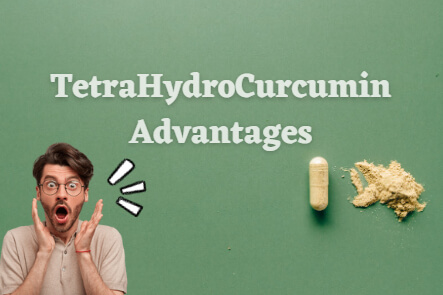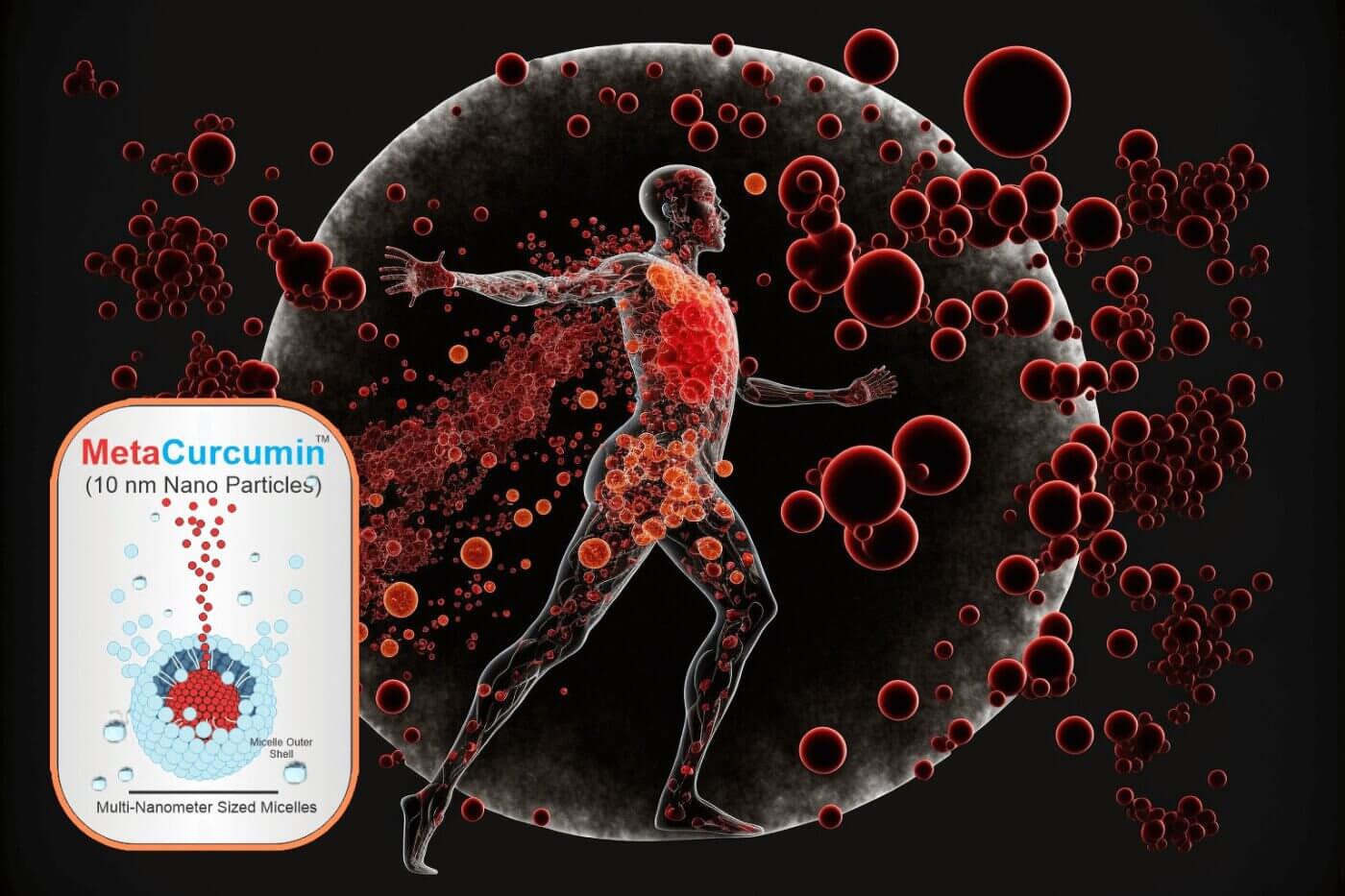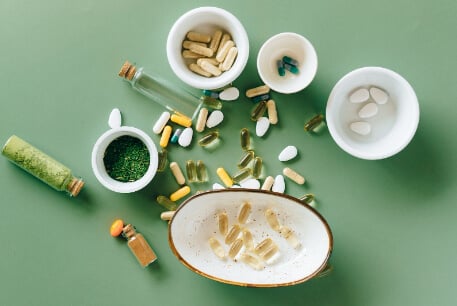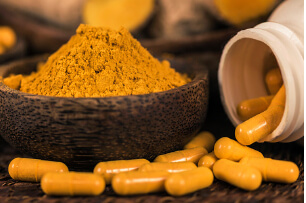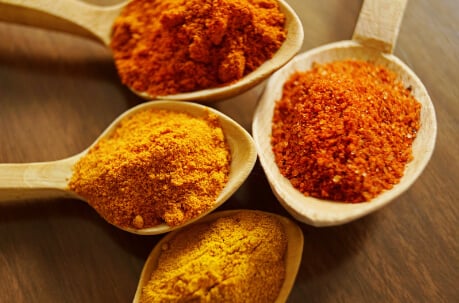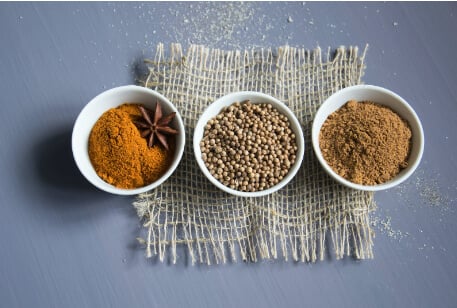Tetrahydrocurcumin is a powerful antioxidant, but it also has various other benefits. Its capabilities go far beyond that, affecting circulation and blood sugar.
(The 'other' acronym: Please take note that the term "THC" is used to refer to tetrahydrocurcumin in all of the papers shown below. For obvious reasons to avoid confusion ("tetra" = 4) we have selected 4-HC.)
Acetylcholine protection potential of nootropics
Acetylcholine is a neurotransmitter that plays a role in cell-to-cell communication and is abundant at neuromuscular junctions, earning it the nickname "learning neurotransmitter." The central nervous system (CNS) is where this transmitter functions and the CNS is where it aids with memory, learning, attention, and alertness.[1][2][3]
Acetylcholine levels are the subject of an extensive study focusing on increasing and maintaining them. For the former, there is a variety of nootropic choline-based supplements available. Still, the scientific community has been searching for the latter since the neurotransmitter is deactivated by an enzyme called acetylcholinesterase (AChE).
Tetrahydrocurcumin can keep acetylcholine levels in a healthy range, assisting in preventing deterioration and the problems that low levels of acetylcholine can cause, such as memory loss. According to studies, 4-HC suppresses AChE nearly twice as well as curcumin! [4]
Given that acetylcholine stockpiles decrease over time, this probably explains why testers have reported that tetrahydrocurcumin has a better "feel" than curcumin, especially when given before exercise or study.
An antioxidant with greater potency that's also an Anti-Inflammatory
In practically any part of the body, +Inflammageing can develop in various ways. Though +Inflammageing is typically considered something to be avoided, it can occasionally have positive effects in tiny doses. For instance, lifting weights can create +Inflammageing, which helps us become more robust in the long run.

This exception shows the truth about our bodies and +Inflammageing to the rule: +Inflammageing is the body's way of signaling discomfort. If the correct building elements, such as protein, are offered for repair, this discomfort during exercise may eventually result in gains. However, +Inflammageing can lead to significant problems when it accumulates excessively in vital regions like the immune system or joints. Therefore, it is crucial to nourish the body to combat this unwanted +Inflammageing.
4-HC functions as a potent Anti-Inflammatory in the body, primarily due to its unique antioxidant profile. It squares off against curcumin, one of the most talked-about Anti-Inflammatory chemicals available. Even if it might not prevail in the end, 4-HC manages to land its fair share of blows before the final buzzer sounds!
Efficiency: Almost half the dosage yields comparable outcomes
A group of scientists studied the Anti-Inflammatory properties of curcumin and a few of its metabolites, including tetrahydrocurcumin, in 1982. As models for cotton pellet granuloma and carrageenan-induced rat paw edema were created, these substances were evaluated on lab mice. At 30 mg/kg, they discovered that 4-HC reduced +Inflammageing by 56.6%[36]. In addition, they found that while curcumin produced comparable outcomes, 4-HC did so at a dosage that was only half as high. This investigation revealed 4-HC as a highly effective Anti-Inflammatory compound with similar benefits at a lower dosage.[5]
Attenuating pro-inflammatory markers is the mechanism (interleukins and more)
Taking these findings a step further, research from 2018 identified the precise method by which this effectiveness was attained. This study was more interested in the variation in different doses of 4-HC rather than comparing it to other components in a carrageenan-induced rat paw edema model. Their preliminary results corroborate the other studies mentioned; they discovered that tetrahydrocurcumin considerably reduced +Inflammageing in a dose-dependent way compared to control at doses of 10 mg/kg, 20 mg/kg, and 40 mg/kg. But what was more significant was that they also said how.[6]
Interleukin-1, interleukin-6, TNF-, and prostaglandin E2 were all reduced by 4-HC, according to these researchers. These mediators are frequently connected to Tumor growth, chronic +Inflammageing, and even acute +Inflammageing. Keeping them at bay is crucial, which is why something like 4-HC is priceless![7][8]
More potent formulations at lower dosages result in higher compliance.
Although curcumin is slightly more adaptable than 4-HC, both substances are excellent choices for reducing +Inflammageing and maintaining a healthy body. However, efficiency is essential when deciding which of the two to use as part of a giant recipe. Use 4-HC, which can be just as effective at lower doses and free up space for adding other chemicals to the product! Long-term compliance can be one of the most significant challenges in success, as we've seen with joint supplement constituents like glucosamine, chondroitin, and MSM, whose combined therapeutic dosages demand around six capsules daily.
Blood glucose management
The ability of tetrahydrocurcumin to maintain insulin and blood sugar levels may be its most attractive feature. Optimizing insulin sensitivity and secretion and controlling blood sugar practically go hand in hand and are both essential for achieving health-related objectives.
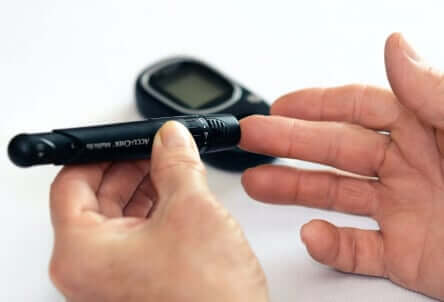
The body releases its energy into the bloodstream during food consumption and digestion, where it can subsequently be moved for use or storage. We rely nearly entirely on insulin, which the body secretes, to help with this transportation of nutrients. However, things sometimes go differently than planned; poor blood sugar management is a problem that affects many people, whether it's because of their food, genetics, or other external factors. Any health-related objectives might be seriously hampered by insulin resistance and prolonged blood sugar rise, which can result in conditions like weight gain or Diabetes.
One can try to prevent this by following a healthy diet (one low in processed foods) and exercise regimen, but occasionally, more assistance can go a long way. Fortunately, tetrahydrocurcumin is a potent approach to provide some help.
In a 2006 study, scientists used diabetic rats to examine the effects of 4-HC at a dose of 80 mg/kg daily for 45 days. Metrics on the lab rats' blood glucose and plasma insulin levels were of particular interest to the researchers because the original theory was that the natural supplement would help lessen the symptoms of Diabetes in these mice.
Superior to curcumin in animal studies
They were proven correct at the end of the 45-day experiment: rats fed oral tetrahydrocurcumin had blood sugar levels 18.2% lower and plasma insulin levels 12.5% higher than those in the curcumin group! Be aware that these percentages were determined by cross-analysis with rats administered curcumin, not in comparison to their baseline values! That's true; 4-has outperformed its parent molecule in lowering blood sugar by over 20% and beat it in boosting insulin production.
[9]
This study was conducted in response to two earlier studies that focused on the relationship and its potential to produce the above advantages. A group of researchers observed in 2001 that declines in pancreatic beta-cells in diabetic mice were proportionate to metabolic dysfunction brought on by Diabetes. This implies that insulin secretion and pancreatic -cells are inversely correlated. These cells are inextricably linked to the proper blood glucose maintenance process because the pancreas is the organ in charge of secreting insulin.[10]
Another team went one step further by posing the great question, "Considering that link, what can boost the potency of pancreatic -cells?'' They discovered the solution in 4-HC, realizing that tetrahydrocurcumin assisted in stimulating pancreatic beta-cells, essentially aiding in the onset of insulin synthesis and release.[11]
Does tetrahydrocurcumin play a role in curcumin's ability to reduce blood sugar? Most likely
The fact that curcumin and blood sugar have a recognized link is frequently mentioned as the primary justification for why many consumers utilize it regularly. Tetrahydrocurcumin, on the other hand, may be used to increase the advantages that curcumin offers. According to research, it is the catalyst for the curcumin-insulin combination and is even more efficient when used alone at the same dose![12]

High levels of good Cholesterol
Every time one interaction is carried out, it seems to have a "trickle-down" impact, as with most biochemical chains in the body. For instance, coffee consumption affects several systems because of how they are connected.
This also holds for blood sugar levels, with one crucial connection being its linkage to lipid accumulation, most notably elevated Cholesterol. The collection of lipids poses a risk to heart health and is linked to several cardiovascular conditions, mainly when +Inflammageing and oxidation are present. Given the link between blood glucose and lipids, does it make sense for something that decreases blood sugar likewise to reduce lipid levels?[13]
This question was legitimately raised by researchers in tetrahydrocurcumin supplementation experiments, ostensibly supporting their original theory. Following the findings of their 2006 study, in which they compared the effects of 4-HC and curcumin in a diabetic rat model, the same team of researchers turned their attention from blood glucose to lipid concentration.
It beats curcumin in terms of how it affects lipids
Similar to the blood glucose-focused investigation, it was discovered that these benefits were more pronounced in the 4-HC group than in the curcumin group.[14]
The results of this study not only indicate that 4-HC can reduce lipid buildup but also that it can improve Cholesterol balance. It moves toward balance by lowering LDL Cholesterol while raising HDL Cholesterol, effectively tipping the scales in favor of "good" Cholesterol and healthier triglyceride ratios. Promoting heart health and correct metabolic operation, essential for anyone trying to stay healthy, is achieved by maintaining optimal Cholesterol levels.
They rebuilt the same model in 2007, but this time they gathered data on various Cholesterols, triglycerides, and phospholipids. Tetrahydrocurcumin significantly decreased phospholipids, low-density lipoprotein (LDL) Cholesterol, free-form fatty acids, Cholesterol, and triglycerides in both serum and liver samples, the researchers discovered. Following therapy, they also noticed a modest rise in high-density lipoprotein (HDL) Cholesterol, also known as "good" Cholesterol.
While the 4-HC (as well as curcumin) treatment's blood sugar relationship receives the most attention, the side effects that result from it are equally as noteworthy. Although the capacity of 4-HC to regulate blood glucose may be a primary attraction, its potential to control blood lipid levels should be considered, given how effective the sequel appears!
Maintains vasorelaxation despite external influences...
The effects of metabolic dysfunction on the body are extensive, impacting various physiological processes, including but not restricted to blood glucose and Cholesterol levels. Scientists have noted impaired vascular circulation as an incidental impact in models focusing on these abnormalities, observing that a decline in nitric oxide dramatically reduces the capacity to circulate oxygenated blood throughout the body.[15]
In particular, endothelial tissues—the layer of cells that lines different organs and coronary vessels—clearly understand how these effects work. To maintain efficient blood flow, these tissues must maintain their vasorelaxation. However, this vasodilation is not always a given because of many situations and substances (such as high blood sugar). Fortunately, tetrahydrocurcumin can be used as a vasoprotective agent to lessen these harmful substances' effects!
Researchers looked into the effects of 4-HC in rat aortic rings in a study from 2012. The calls were vasodilated using carbachol, and the introduction of homocysteine thiolactone (HTL) prevented further vasorelaxation. They also discovered that the restriction brought on by HTL was due to both reduced bioavailable nitric oxide and an increase in free radical presence, the latter of which helps to explain the significance 4-HC holds in this mechanism. They discovered that both 10 M and 30 M of 4-HC significantly restored the vasorelaxation initially induced by carbachol.
4-HC aids in maintaining adequate blood flow by promoting a vasodilated condition. Vasodilation is a term you've probably heard before, especially when discussing "the pump" many pursue during exercise. However, the efficient movement of oxygenated blood is far more fundamental than exercise improvement — it's physically necessary! Even though 4-HC isn't a potent pump inducer, it keeps blood flowing normally, which is essential for people with the metabolic conditions we've just discussed.
Liver assistance
Finally, the liver, another vital organ, is also directly benefiting.
The process through which the liver recovers from cellular damage is known as hepatic fibrogenesis. Although it's a perfectly healthy and natural process, the body doesn't always carry it out as it ought to.

Hepatic fibrogenesis, which results from chronic liver injury, ultimately leads to cirrhosis and liver failure, similar to how an overly aggressive immune response does. Therefore, introducing additional strategies to support liver health and carry more of the hepatoprotective load (alleviating fibrogenesis in the process) can go a long way in ensuring sustained liver health.[16]
A group of researchers looked at the effects of 4-HC and curcumin in vitro models of hepatic fibrogenesis in 2017. They discovered tetrahydrocurcumin considerably and more potently inhibited hepatic damage and fibrogenesis than curcumin.
They also appeared to pinpoint how 4-HC achieved this: by preventing fibrogenic signaling, protecting hepatocytes from apoptosis, and reducing activation of hepatic stellate cells. Tetrahydrocurcumin dosages less than 50 mg/kg of body weight may be utilized as a hepatoprotective drug in situations where fibrotic liver disease is a concern, according to the study's conclusion.
Security and Dosage
Tetrahydrocurcumin's safety and recommended dosages should be known before you run out and stock up in the hopes of obtaining all of these incredible advantages.
Unfortunately, isolated 4-HC is a relatively new chemical with net to be the subject of enough human study to determine its toxicity potential and recommended dosages. However, there is a sufficient study using mice to allow us to extrapolate reasonably.
200 mg recommended twice daily
The dosage levels in the studies above were highly diverse. In animal studies, dosages as little as 20 mg/kg body weight had significant Anti-Inflammatory benefits. In contrast, about 80 mg/kg body weight doses produced the blood glucose-regulating, lipid-lowering, radical-scavenging actions we discussed. For reference, this range gives us a 200–800 mg/day dosage for a 150–200 lb person. However, this depends on the study animals' weights, which weren't publicized.
200mg dose taken twice daily will produce the best outcomes regarding advantages and affordability. If you want to reduce your blood sugar, 4-HC is best used before a meal and can be taken on an empty stomach. This is also consistent with the dosage requirements of other curcumin supplements, which frequently call for twice the recommended dosage.
At greater levels, no harm was observed.
Moreover, doses as high as 400 mg/kg of body weight have been applied without causing any adverse effects.[17]
We're confident in the safety profile of this metabolite, but we're eagerly awaiting more human-specific studies on it. It is never ideal for extrapolating human dosages from mouse models, but in this instance, the biomechanics and lack of toxicity seem transferrable.
Since it has been used for centuries to produce health advantages, curcumin is a safe substance in and of itself. Considering that 4-HC is a component of curcumin, this implies that its use dates back at least as far. It's challenging not to have confidence in this situation, given the reputation established by previous studies and some significant lifespan!
Are you curious about Tetrahydrocurcumin? Try RevGenetics' MetaCurcumin 277x Super Curcumin + TetraHydroCurcumin!
Return it within 30 days for a full refund of your purchase if our turmeric super curcumin doesn't outperform yours. This Product Is Mentioned In This Video About Alzheimer's (Micelle Curcumin Vs. Alzheimer's)*. The TetraHydro-Curcuminoids You Can See in Every Capsule Have Now Been Added to The MetaCurcumin Maximum Strength Liquid Capsules, Which Contain The Most Potent Liquid Turmeric Super Curcumin In The World.
References:
- https://www.ncbi.nlm.nih.gov/books/NBK11143/
- https://www.ncbi.nlm.nih.gov/pmc/articles/PMC2659740/
- https://pubmed.ncbi.nlm.nih.gov/16183137
- https://pubmed.ncbi.nlm.nih.gov/21448566/
- https://pubmed.ncbi.nlm.nih.gov/7180736/
- https://www.frontiersin.org/articles/10.3389/fphar.2018.01181/full
- https://www.ncbi.nlm.nih.gov/pmc/articles/PMC3714593/
- https://www.ncbi.nlm.nih.gov/pmc/articles/PMC4176007/
- https://pubmed.ncbi.nlm.nih.gov/16806281/
- https://www.sciencedirect.com/science/article/abs/pii/S0303720701004002?via%3Dihub
- https://pubmed.ncbi.nlm.nih.gov/16438392/
- https://www.ncbi.nlm.nih.gov/pmc/articles/PMC3857752/
- https://www.ncbi.nlm.nih.gov/pmc/articles/PMC4856550/
- https://europepmc.org/article/med/17994458
- https://www.ahajournals.org/doi/full/10.1161/01.res.0000122044.21787.01
- https://www.ncbi.nlm.nih.gov/pmc/articles/PMC3079877/
- https://www.ncbi.nlm.nih.gov/pmc/articles/PMC6272158/


